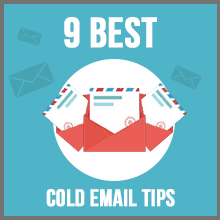
Do you ever wonder what makes a great cold email?
Would you like to learn the strategies behind the best emails?
If yes, then you landed at the right place.
No worries if you are new to the world of cold emailing.
I am keeping this beginner-friendly yet informative at the same time.
In this article, you will learn a step-by-step approach to creating killer cold emails no matter what you need them for.
Find out how to turn leads into prospects, request meetings and make new connections all through an email.
Whether it is your first time or you have done this a lot already,
you will still benefit from the tips I am sharing here.
Keep reading to learn the exact techniques which I have used personally to reach out to strangers over the internet.
Tip #1- Research
Whenever I want to cold email someone, I begin with research. Digging information about my lead is important because I need to know who I am contacting. I use Google, LinkedIn, Twitter, Facebook and company/personal websites for lead research.
I will briefly walk you through how to use each platform to find information or new leads.
Using LinkedIn For Research
The first method is for digging up contact information for a particular person. Let’s say, I want to find out more about “Rudran Blake” as well as get his email address. So, I enter his name in Google and go through the results.
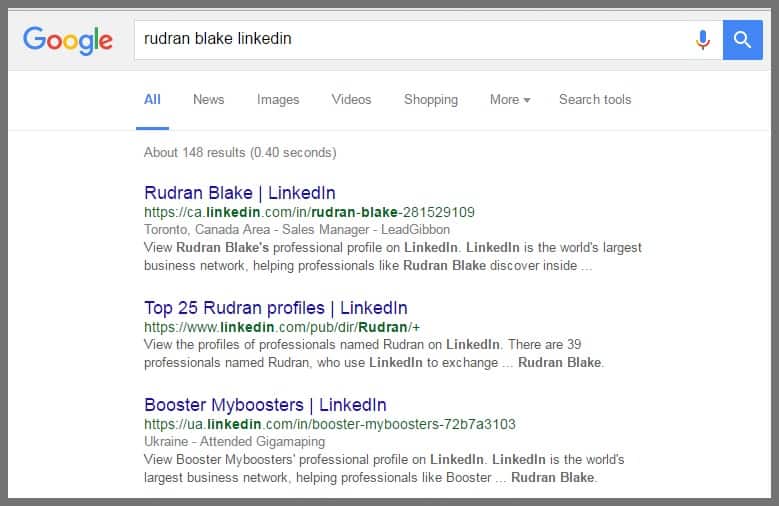
I see that most of the results point to LinkedIn. This is a good place to find professional information, so I click on the top 25 Rudran profiles to see if the person I am searching for is using this platform.
Turns out, the first profile in the LinkedIn results is the one I want. I can then view my lead’s LinkedIn page, connect with them or find out more by going through their profile.
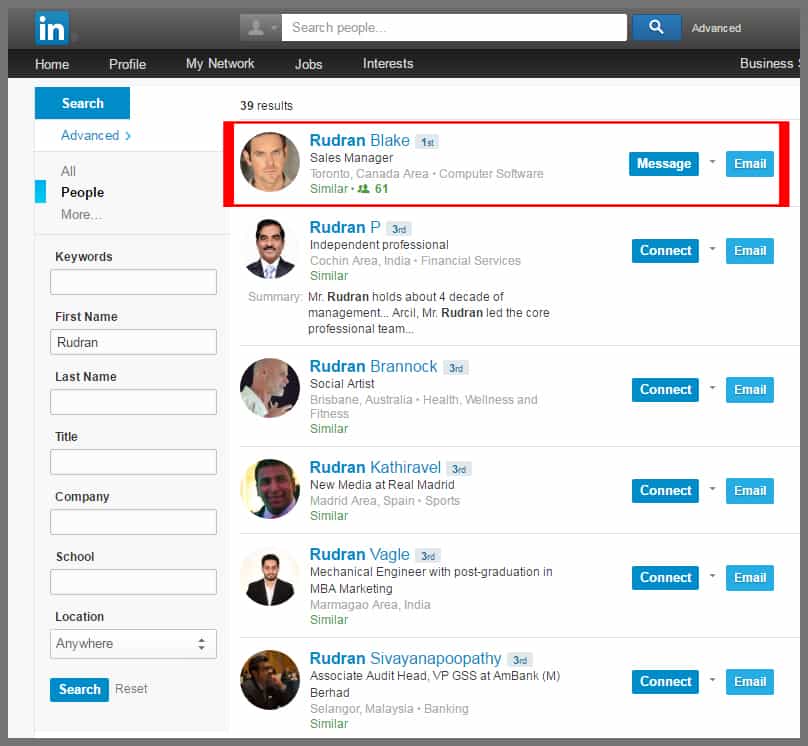
Notice the email button near each user? This is not a LinkedIn feature. I have installed the LeadGibbon extension and this helps me find the email address of any LinkedIn user so I can contact them via email.
You can use this extension to quickly perform an email address search as well as lookup the email address of your leads who happen to be on LinkedIn without having to send them an invitation to connect.
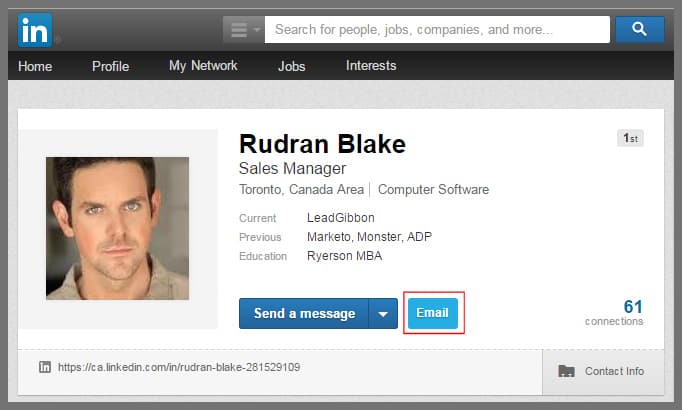
If you want to find email addresses on LinkedIn, then get the LeadGibbon extension. Once installed, navigate to LinkedIn and click on the email button that appears near the user whose email address you want to generate.
A sidebar will appear and you can then click the Gibbon icon to find the verified email address of your prospect.

Using LinkedIn to find people with specific titles/jobs
Let’s say you are looking for leads by job title. I would recommend using LinkedIn’s advanced search features because it can help you find people based on their job titles easily.
For example, I want to look for people who hold VP of marketing positions. All I have to do is enter the keyword “VP marketing” in LinkedIn’s search bar and click on the search button
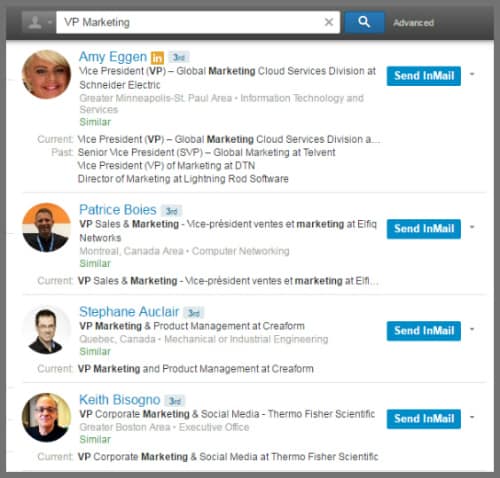
The search process generates profiles of people, groups, companies or jobs related to my search term. I can further narrow down the search to only display results that I am interested in by adding more relevant information to the search sidebar on the left.
I also narrow down the results to display profiles of those who are in the marketing and advertising industry from the United States. Filtering results the way I did will help you find the right people so that you can craft your cold email to your specific lead.

Using Social Media
Apart from LinkedIn, you can also use social media such as Twitter and Facebook to search for leads. Both these platforms use keywords during the search process to generate results. Type in the keyword and hit search.
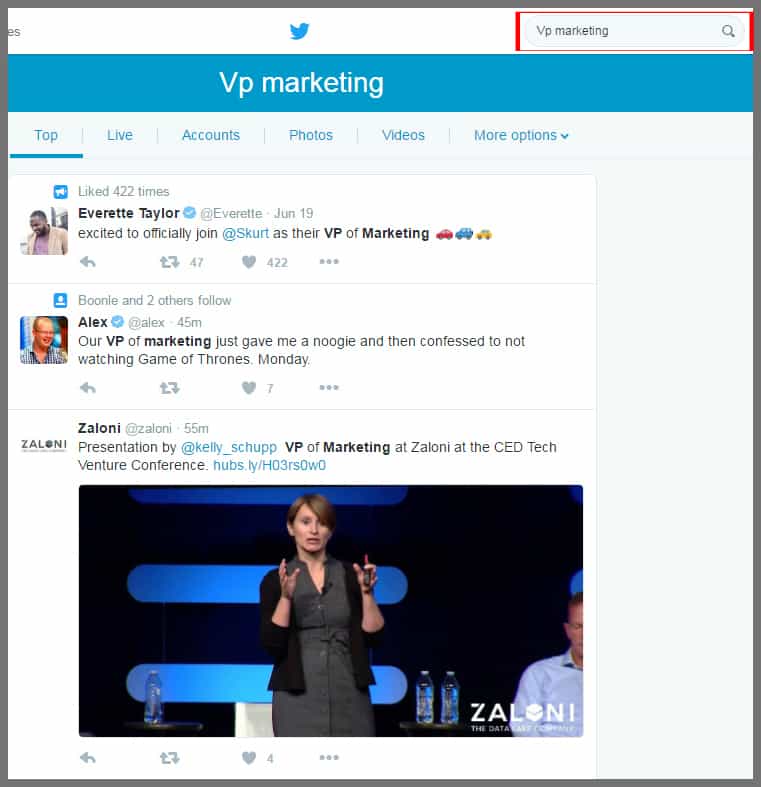
Once the results appear, narrow down the results by clicking on accounts on the top bar. This will filter out the rest and only shows you accounts of people who are related to the keyword terms. You can then browse through the results and open profiles of those who seem like possible leads. Note that the same search process applies to Facebook as well.

Using websites or blogs
Company websites or personal blogs can also be another place to find contact details of your leads. Apart from the email address, familiarize yourself with the name, position as well as find some background information on your lead.
I am looking for the VP of marketing comScore. So I use Google to do a quick search. The first result points to comScore’s website and that’s where I will go.

Below is the profile of Comscore’s VP of marketing, Andrew Lipsman, on their official website. Apart from links to social networks, there is information about his education, his area of expertise as well as books he has written. All of these tidbits are useful and can serve as the basis for more research on Andrew.
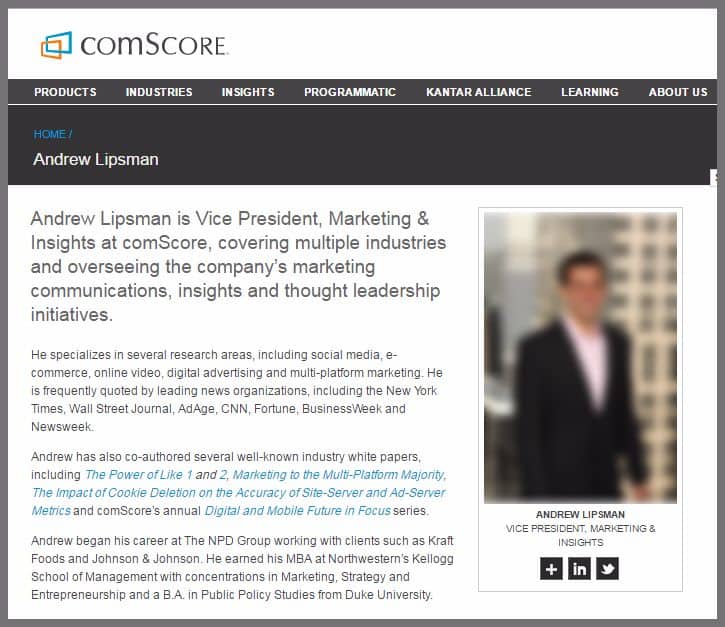
Pro tip: Email Format Checker is a great way to access company information. Simply enter the company’s domain and you’ll get its description along with a list of employees and their positions.
Searching through Andrew’s profile, I’m unable to find his email address, just a link to Andrew’s LinkedIn page. So, I head over to LinkedIn and using the LinkedIn email finder tip I mentioned before, I can go ahead and use LeadGibbon to find Andrew’s email address. I now have some background information on Andrew Lipsman and as well as his email address. The only thing left is to create and send a good cold email using the next 8 cold email tips in this article. I’m going to start with the subject line.
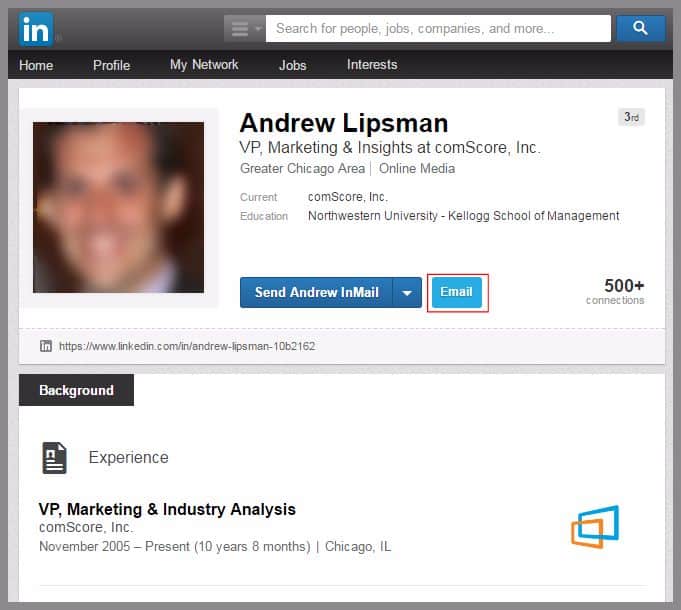
Tip #2 — Focus On The Subject Line
There are so many ways to write a subject line. However, according to the data accumulated by Experian, some subject lines fare slightly better than others with regards to open rates.
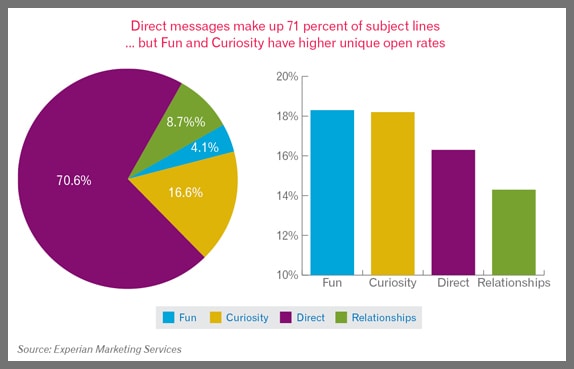
Source: Experian
When I send a cold email, I want the receiver to open it, read through and respond. It is a given that the subject line is the deciding factor on whether the email will be opened or not. This is because the subject line is what we see apart from the sender’s name.
Below are some examples of good subject lines that lead to better open rates right from my personal inbox.
Arouse curiosity
Instead of lengthy subject lines, go for creative ones that will arouse curiosity. When your prospects are curious, they will be more likely to click what you sent and read through it.
Below is an example. This subject line immediately arouses curiosity due to the way it is crafted. I can’t help but open this since I am curious to find out what Brian Dean wants to ask.

Use the lead’s name
Another tip for a subject line that works is that you could also address the prospect by name in the subject line in order to draw their attention. A lot of people stop at the sight of their name and this is exactly what you want.
The main purpose of your subject line should be to stand out among the rest of the emails that are fighting for your prospect’s attention.
The two emails I have highlighted below use my name in the subject line. I find this compelling because it’s personal and this pushes me to go ahead and take a look at what the message contains.

Go straight to the point
Apart from that, you could also get to the point directly in the subject line. This is especially useful for those emails in which you are requesting a meet-up or a conversation with the prospect.
In the subject line below, it is clear that someone wants to ask me a question and it won’t take much time. This straightforward approach works well in most cases, so give it a shot.

Provide them with something of value
Offer value to the recipient and they will be likely to open and read through. If you know the interests or hobbies of your leads or something that they are in search of, you can find out more about that and use it as an opener. Just be sure to tie this back to your core message.
I am trying to build a new website that will rank well and provide me with a loyal audience who will recognize me as an authority on the subject. So, when I receive emails that contain useful tips on how to create a great website, I just have to read through. Subject lines that speak to this will automatically capture my interest simply because it is top of mind for me right now.

Bonus: Check out Hubspot’s detailed article on 26 sales subject lines that get prospects to open, read and respond here.
Tip #3 — Personalize It
It’s no surprise that we like to read something that seems like it was written especially for us. For this reason, personalized emails get better response rates as opposed to non-personalized emails.
Take a look at the chart below from Canopy Labs and see how a little personalization in cold emails can go a long way.
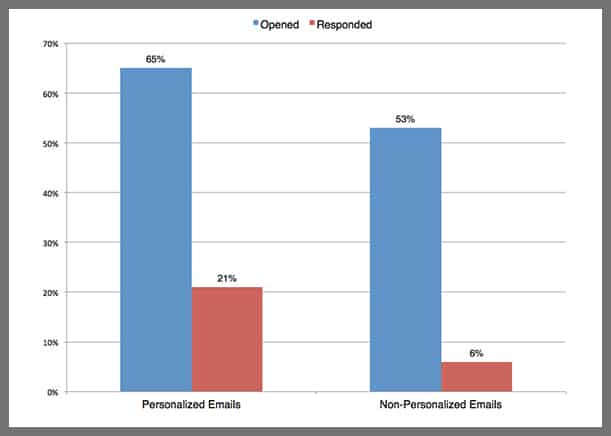
Source: Canopy Labs
When I want to reach out to someone through email, I try to personalize the message as much as I possibly can. I spend time learning more about that person, their interests, what they do in their free time, the latest happenings in their lives etc. In short, I try to find anything that will help me know them better as a person.
Social media makes it easy to take a sneak peek into the daily lives of others. So, I make sure to follow the person I intend to connect with on social media platforms such as Facebook, Twitter, and Instagram in advance. I go through their old posts, comments, photos, basically anything that they share with the world, I make sure to check it out.
Below is an example of a cold email by Salesloft that is personalized in all the right ways. Continue reading to find out what makes this highly effective so that you can also replicate the formula.

Source: Salesloft
Strong point #1 — Using the recipient’s name
The best cold emails that show the desired results are the ones in which the name of the recipient is mentioned. Instead of bulk emailing people at once, take the time to address them by name in the email.
Strong point #2 — Talk about them
In order to personalize a cold email, it is important to show that you have researched your prospect. Compliment them or mention what you like about their work. In the example email, the sender does just that in the opening paragraph.

Strong point #3 — Get to the point quickly
After the pleasantries, the sender gets straight to the main point. He mentions the reason why he wants to connect, a specific date and also a particular time. Make sure your emails prompt a response from your recipient. Always include a Call-to-Action as illustrated below.

Bonus: The main reason why personalization is important is because you want the other person to be able to connect to you. So, if you share a common interest, then you can mention that as well. This will help your lead relate to you more easily which means taking advantage of relationship selling in the future.
Need some more help with personalized emails? Head over to this awesome article at PersistIQ for more information on this topic.
Tip #4 — Keep It Short
With messages flooding the inbox on a daily basis, no one has the time to go through a lengthy email. I personally receive hundreds of emails a day and I hate it when I have to open ones that are a page and half of text. I would rather skip a long email than skim through it or read the whole thing despite what it contains.
So, do yourself a favor and keep your emails short, preferably less than 300 words.

Below is a cold email that has the perfect length. Notice how the sender gets to the point quickly in just a few lines. There is no random stuff or irrelevant information in the body.
Right from the start, you can see that the sender has an idea that can help increase customers for the recipient, which he wants to share through a phone call. That’s compelling.
The word count is very low and it takes only a minute to read through the whole thing.
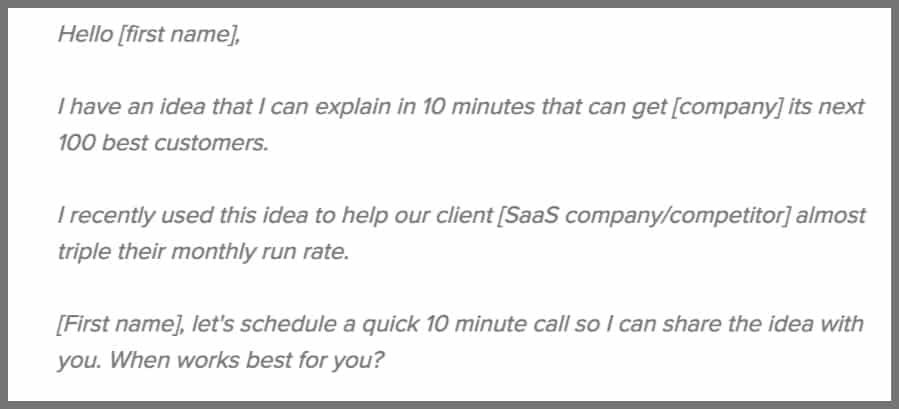
Source: Salesfolk
Another way to cut down on word count is to link to an external source to provide more information. With this technique, the email stays within a reasonable length and you can still provide helpful advice to your leads.
Tip #5 — Make It More About Them Than You
This point should be a no-brainer but it is shocking to see how many people still do this. They will cold email someone for the first time and directly try to shove a product or go on endlessly about themselves. I blame such people for the bad reputation of cold emails.
Just like any other person, I cringe at the sight of emails that contain purely promotional content with no value whatsoever.
Below is one such email. Once you are done reading it, keep scrolling down to find out why I think this is a horrible way to introduce a product.

Where exactly did the sender go wrong? Well, let’s perform an autopsy on this email.
Mistake #1 — Too much focus on the sender and his product
The sender is talking only about himself and his app. The email is not personalized at all, it seems like a bulk message that is sent to everyone regardless of what their business is about. The sender makes assumptions and tries to portray his product as something extremely valuable without any proof as you can see in the paragraph below.

Mistake # 2 — Direct selling
Another mistake the sender makes is selling his product right away. He goes on to directly talk about price without warming up his offer. There is no reason why I’d want to this product even if it were free. It’s not about the money, it’s about what I will get in return
I am still confused about what exactly this product is about and I have no desire to find out since I am not sure how I will benefit from this. There is no marketing creativity and it even feels like spam, to be honest.

Mistake # 3 — Weak conclusion
Again, when it is time for the conclusion, the sender fails to add something of value. He again tries to pitch a sale without explaining what his product is about or how it might help me.
There is no background information or any relevant links to resources where the lead can find out more about this product. The Call-to-Action here is open and ambiguous. This email does not even request an immediate response and the likelihood of getting one is slim to none.

As you can see, there is a fine line between prospecting and seeming like a salesperson. No one wants to be sold to, so try to keep the balance. If you make your email more about your prospects, they will be more likely to show interest. If you do have to mention yourself, make sure it relates to something they might benefit from.
Tip #6 — Pay Attention To Grammar
When you are composing a cold email, it is okay to be informal or to write naturally at times. However, this does not mean that you ignore typos or the basic rules of grammar and punctuation.
No matter what tone or style you are writing in, it is always important to use correct spelling, proper punctuation, and good grammar. Not only does an email full of typos seem unprofessional, but it also takes away from the purpose of your message.
If you are not very good at proofreading, then consider asking a friend or colleague to go through your writing and make the necessary changes for a more polished email.
Grammarly is a useful proofreading tool that you can use as a chrome extension. I noticed that this tool works better than many spell checkers I have used over the years. Also, the premium version offers additional tools such as vocabulary enhancement and proofreading services by an actual person.
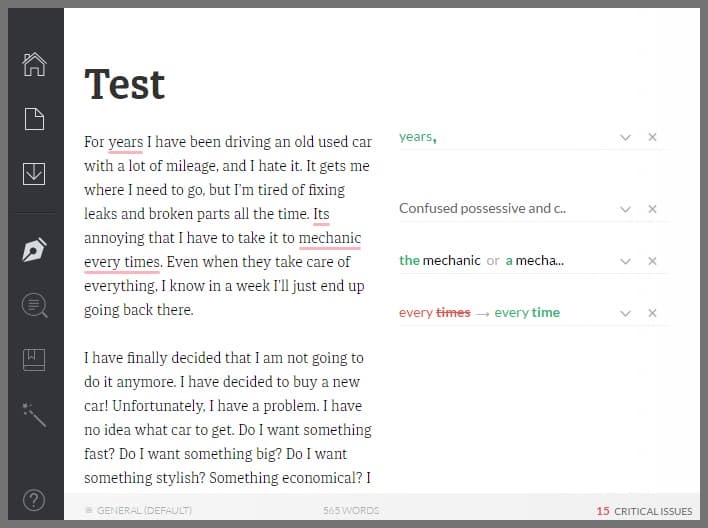
Below is how Grammarly works with Gmail. It highlights typos and suggests corrections right inside the compose window.

If you need an expert opinion on your cold email then check out Salesfolk. They have a course on how to write compelling cold emails and you can also request for a consultation in which they will critique your email and provide feedback on how to make it better.
Another great service to help with your cold emails is Breakthrough Email. They have helped an impressive list of big brands create targeted cold emails to help turn leads into customers. They also offer a free toolkit that contains a sales email template as well as cold email tips which you can use for writing your own emails.

Source: Breakthrough Email
Tip #7 — Consider The Best Time
One of the most important cold email tips to keep in mind is timing. According to an article by Coschedule, certain times are best for sending emails. This is because most people check their inboxes at specific times and are more likely to reply right away. These rules may not apply to all markets but it’s a good tip to keep in mind. As always, make sure you’re testing and keeping track of what works best for your product/organization.
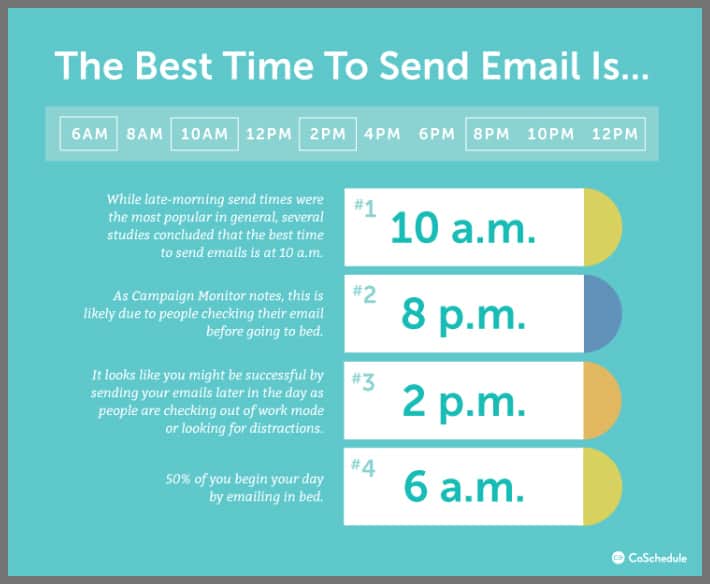
Source: Coschedule
Apart from time, you also need to consider the best days to send a cold email. Even though there are no hard and fast rules here, Mondays, Tuesdays, and Wednesdays have the highest open rates according to Hubspot.
You can use this data as a guide when scheduling your emails.

Source: Hubspot
Personally, I check my inbox first before I begin working. If an email requires my immediate attention, then I settle that first. Later on in the day, I deal with less urgent emails.
Other people might have different inbox habits, it all depends on their own routine. So, you will need to experiment to find what time is best for which person.
To make life easier, there are many email scheduling programs that automatically send out emails on specified days and times.
One such plugin is Boomerang. There is a version for Outlook users and another one for Gmail users. This plugin can schedule and resend emails on specific days and times right from the inbox.

Yesware is another plugin that works with both Gmail and Outlook. You can schedule and send an email later with the Yesware toolbar. Also, You can choose different time zones depending on the location of the recipient. This way, they will receive the email based on their local time.
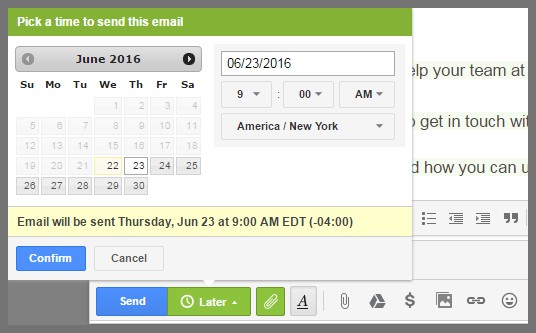
Tip #8 — Monitor Performance
Once you have sent out your email, it is also important to monitor performance. There are many programs available that help you track the emails you send. These programs give you statistics based on whether your email was opened or not. Many sales automation platforms such as PersistIQ, Reply, Outreach, Salesloft etc. automatically provide you with these statistics. And don’t forget about various Gmail read receipt extensions.
These programs are good for monitoring bulk emails and campaigns where you need to track multiple recipients at the same time. You can get quick access to important statistics such as the delivery rate, open rate, number of people who replied etc.
Below is Reply’s dashboard that provides insight into the results of an email campaign. As you can see, it is easy to determine progress with such a platform.

However, if you want to track individual emails right from your inbox, then you can use dedicated third-party software.
Gmail users can install plugins such as MailTrack that will help you track any email you send. The two green tick marks at the bottom of the email editor signify that this email will be tracked.

Personally, I use Yesware for both scheduling and tracking emails. I just have to make sure that the tracking option is selected in the Yesware toolbar before I send out the email.

Once you are aware of the statistics with the help of the right program, you can decide what to do next. If your email remains unopened or it was opened but you did not receive any response, then you need to implement your follow-up plan. Up next is how to create a practical follow-up plan.
Tip #9 — Have A Follow-up Plan
A follow-up plan is very important and you should definitely have one in place. This is necessary in order to get the attention of your leads, however, there is a way to go about this successfully. If you don’t follow-up the right way, it might seem like you are spamming the other person.
You should have a follow-up plan with regards to a couple of scenarios.
- One is that your email was not opened by the recipient. To solve this, you could change the subject line to something better and maybe tweak the content in the email too.
- The second scenario is that the email was opened, but there was no response. In this case, you can rewrite it if you think it could be better or you could resend the same email again. Instead of manually doing this, I recommend using an automated email sender.
Follow-up programs and plugins
Boomerang can also send emails based on the action selected. For example, you can trigger a “Boomerang” that will resend the email if the first one was not opened. Also, see Hubspot Sales.
An alternative to using Boomerang for action-based email triggers is a sales automation platform like Reply. This powerful web-based application allows you to create a follow-up plan in steps. You can add as many steps as you want, with a unique email message for each as well as select the days on which each email will be sent out. You can also apply your rules to multiple recipients if you are working with a big list of prospects and get in-depth data on where your leads have failed to take action.
Below is a campaign I created with one email and 2 follow-up emails with the Reply app.
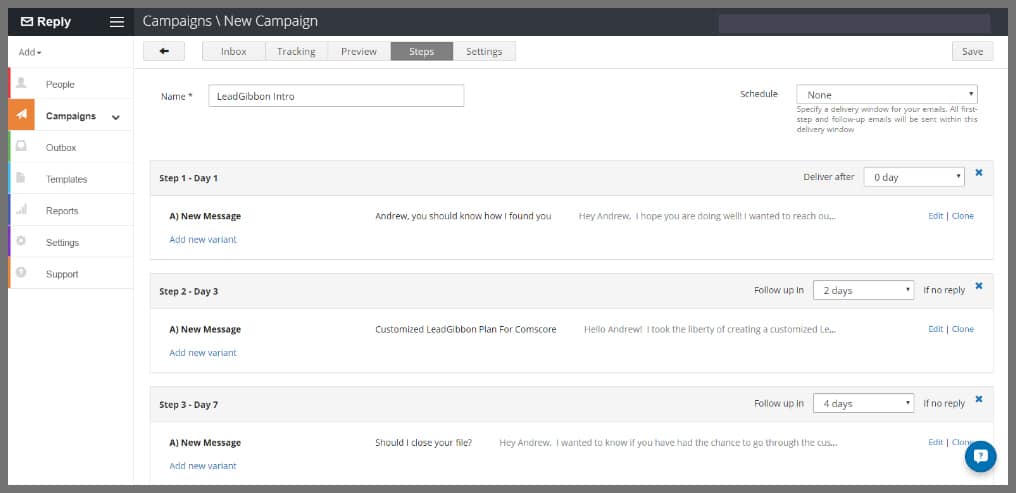
The Yesware toolbar also has a reminder option that you can use to set up alerts on specific days and times. This way, when you log into your inbox, you will receive follow-up reminders automatically.
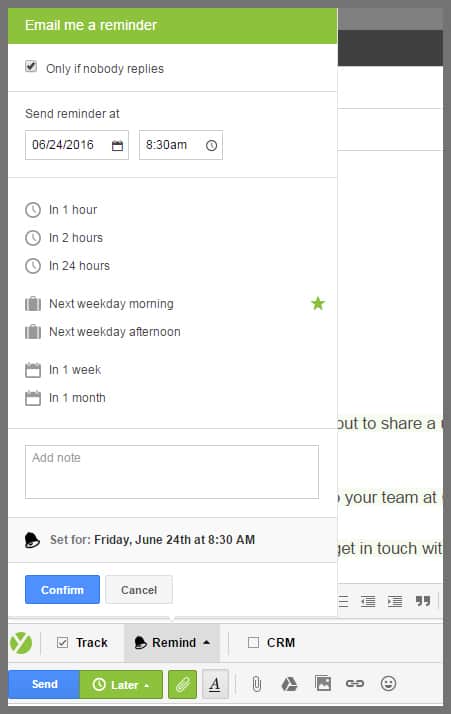
Bonus: Yesware has a bunch of follow up email template ideas that you can use, take a look here.
There are some great lightweight email reminder tools like FollowUp.CC. that users can use as a Gmail plugin to set follow up reminders for themselves. FollowUp.CC also has a response detection feature that lets you know which emails have been opened and which ones haven’t.
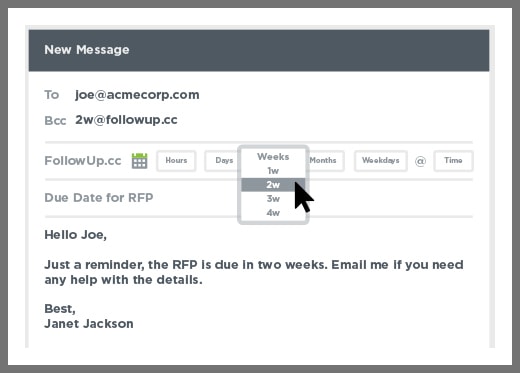
FollowUpThen is an email reminder tool that works on all email platforms including Yahoo, Hotmail etc. The professional plan includes SMS reminders and response detection.

Sales automation platforms for follow-up campaigns
I mentioned a few sales automation platforms earlier in the article. However, I want to quickly share some snapshots of their dashboards to give you some insight into how they work and how they can help you formulate your email follow up plan.
PersistIQ
First up is PersistIQ. This platform provides intelligent sales automation with a human element. You can easily create email campaigns with follow up triggers.

SalesLoft Cadence
SalesLoft Cadence combines both email and phone integration to create a semi-automated sales process. So, you can create a follow-up strategy with both email and phone on this platform.

Outreach
Outreach is another email automation platform that allows users to create cold email campaigns complete with follow up options.
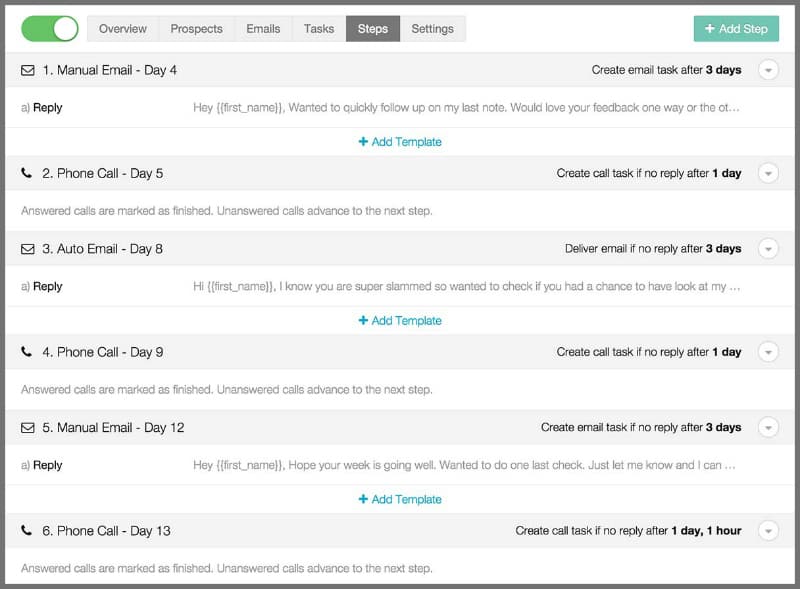
As you can see, a great cold email requires effort and the right techniques. However, with the tips and tools I covered in this article, the cold emailing process becomes simple enough for even a beginner to attempt.
Was this helpful? I’d like to hear from you
Do you have a question about something I wrote? Maybe, you have something else to add?
Whatever the case, leave your thoughts in the comment box below and I will get back to you!

Leave a Reply